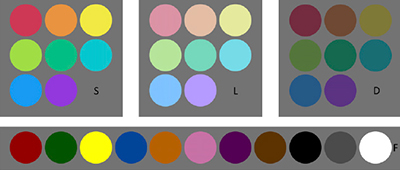
The 35 stimuli from the saturated (S), light (L), dark (D) and focal (F) sets used in the experiment. Credit: Álvaro et al. Proc. Natl. Acad. Sci. USA, doi: 10.1073/pnas.1502104112
People with normal color vision have color preferences that follow a predictable pattern. Researchers from the Complutense University of Madrid (Spain) and the University of Sussex (U.K.) conducted a study of people with red–green dichromacy—a genetic color vision deficiency—to see if they, too, have predictable color preference patterns (Proc. Natl. Acad. Sci. USA, doi: 10.1073/pnas.1502104112). Knowing how genetics affects color preference can increase our understanding of dichromacy and general theories of aesthetics.
About two percent of the male population has red–green dichromacy, where the retinal cone photoreceptors that are sensitive to either long (red) or medium (green) wavelengths are not functional. This genetic disorder reduces a person’s ability to discriminate colors and shifts their spectral sensitivity away from the type of cone they lack. Previous studies have shown that people with normal, trichromat color vision have predictable color preferences—most like blues and dislike yellow-green hues. Lead investigator Leticia Álvaro and her team wanted to find out if people with red–green dichromacy also have predictable color preferences.
The researchers examined 32 people with trichromat color vision and 32 people with red–green dichromat color vision to see how the faulty cone-type affects color preferences. They asked each group to name and rate how much they liked different saturated, light, dark and focal colors. They found that trichromats favored blues and had a low preference for yellow-green hues, consistent with previous studies. They also found that red–green dichromats reliably preferred yellows and had a weaker preference for green-blue and red hues.
Data from the study also showed that trichromat and dichromat males were able to call out the name of their “favorite” color faster than other hues. This finding may provide evidence for linking how easily a color can be named to how much it is liked. For females in the trichromat group, there was no link between speed of color naming and color preference.

